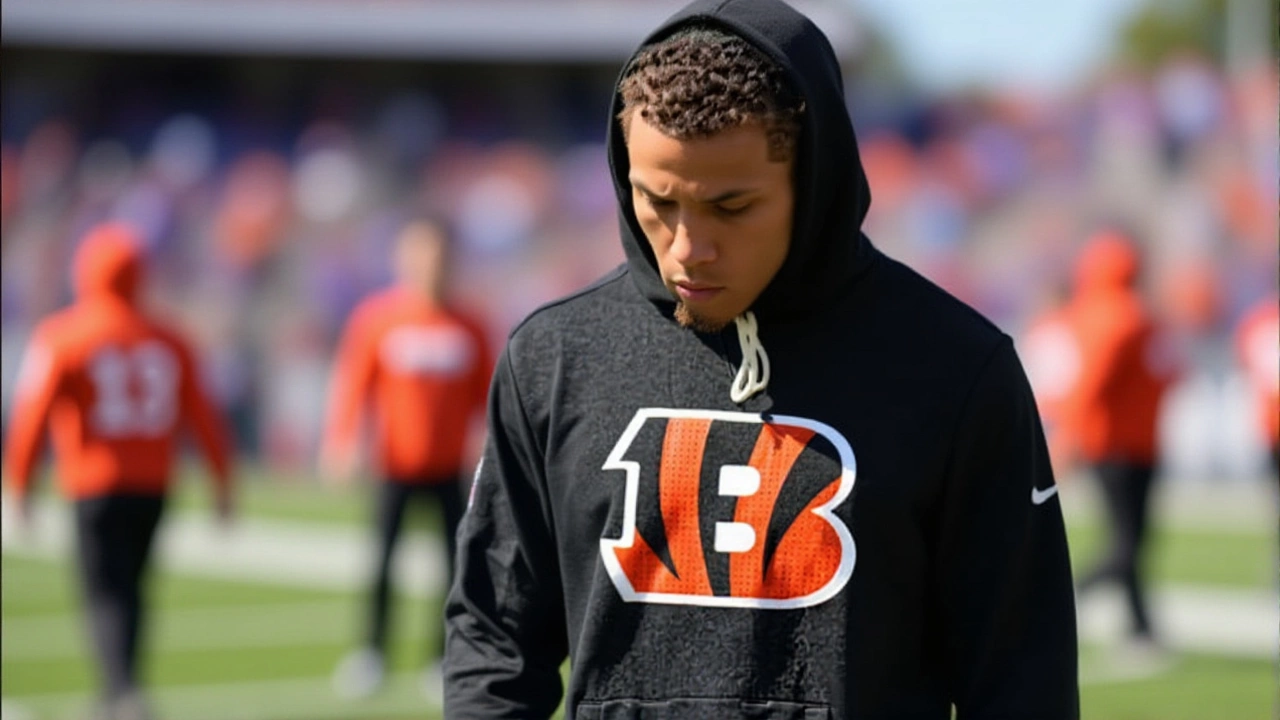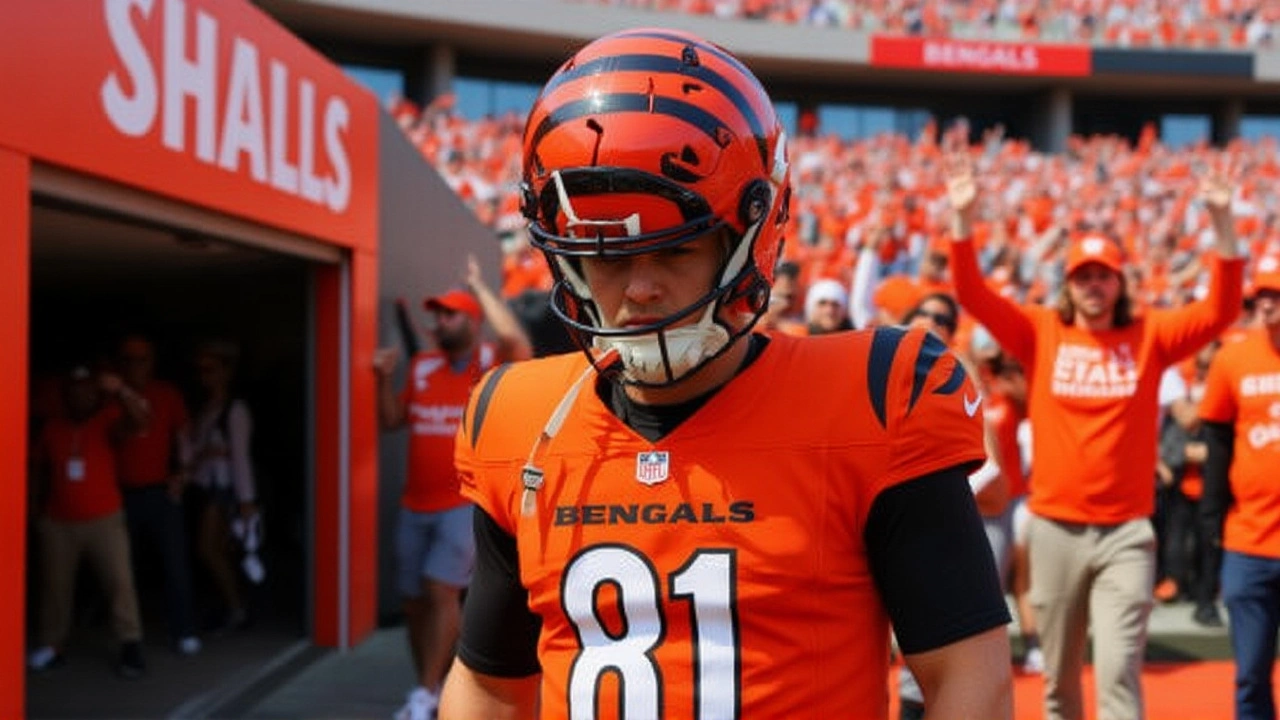When Joe Burrow, the quarterback of the Cincinnati Bengals, twisted his left foot during a 31‑27 win over the Jacksonville Jaguars on , the league confirmed he suffered a Grade 3 turf toe that will keep him out at least three months.
What happened on the field?
The injury unfolded in Week 2 of the 2025 NFL seasonPaul Brown Stadium. Burrow was tackled from behind, his foot forced into an unnatural angle as he hit the turf. He stayed on his feet briefly, but the pain was obvious – he limped to the sideline, required assistance from the Bengals’ medical crew, and eventually headed to the locker room under his own power.
Later, Zac Taylor, the 42‑year‑old head coach, announced on the team’s official Twitter account that Burrow would need surgery to repair the torn ligament at the base of his big toe. No exact date for the operation was given, but the prognosis is a minimum three‑month recovery.
Why the injury matters
The timing could not be worse. The Bengals entered the 2025 campaign hoping to rebound from a sub‑par 2024 season and lock down a playoff spot. Losing Burrow – a 2020 Heisman winner and two‑time Pro Bowler – is akin to a chef losing his knives right before a big banquet.
Burrow’s stats from last season illustrate the gap: he threw for 4,102 yards, 31 touchdowns, and only nine interceptions, completing 68.5% of his passes. The team’s offense ranked third in the league in yards per game. With him sidelined, the Bengals’ chances of making the postseason dip sharply, according to several analysts.
Who’s stepping in?
The immediate answer is Jake Browning, the backup who went 4‑3 as a starter in 2023 after Burrow’s season‑ending wrist injury. Browning, a 27‑year‑old pocket passer, boasts a career passer rating of 94.2 and threw 12 touchdowns in limited action last year.
To add depth, the Bengals elevated practice‑squad veteran Brett Rypien to the active roster and signed quarterbacks Sean Clifford and Mike White to the practice squad. Sources close to the front office say the team is also exploring trade options, potentially targeting a seasoned veteran before the trade deadline on October 29, 2025.
Burrow’s injury history – a pattern of misfortune?
Unfortunately, this isn’t the first time Burrow’s career has been interrupted. In 2020, during his rookie season, he suffered a catastrophic knee injury – tearing the ACL, MCL, PCL and meniscus – which ended his season after just ten games. He missed a chunk of the 2021 campaign with a dislocated pinky and an MCL sprain, then battled a torn wrist ligament that cut short his 2023 season.
Medical experts note that repetitive injuries can affect a player’s long‑term durability. Dr. James Andrews, a renowned orthopedic surgeon who has treated Burrow before, commented to ESPN that “the soft tissues around the toe are critical for a quarterback’s plant and push. A Grade 3 tear means a full ligament rupture; surgery and a disciplined rehab are non‑negotiable.”

What the recovery timeline looks like
Current projections suggest a mid‑December return, around , assuming no setbacks. That would give Burrow roughly three games left in the regular season – not enough to mount a serious playoff run, but enough to give him a chance to regain rhythm before the next year.
Rehab will focus on range‑of‑motion exercises, gradual weight‑bearing, and eventually full‑speed throwing drills. The Bengals’ strength staff, led by Mike Hargrove, has a reputation for getting players back fast, but they’re also cautious after the string of previous surgeries.
Broader impact on the AFC North and the league
The AFC North now looks wide open. The Pittsburgh Steelers, Baltimore Ravens and Cleveland Browns each sit within a win or two of Cincinnati. Without Burrow, the Bengals could slip into a rebuilding role, while the Steelers may seize the top spot.
From a league‑wide perspective, Burrow’s situation adds to an ongoing discussion about quarterback health and the physical toll of the modern passing game. The NFL’s competition committee is reviewing injury‑prevention protocols, especially concerning turf surfaces that have been linked to toe and foot injuries.
Key facts at a glance
- Injury: Grade 3 turf toe (torn ligament at base of big toe)
- Date: September 15, 2025 (Week 2)
- Opposition: Jacksonville Jaguars (31‑27 win)
- Projected return: Mid‑December 2025
- Backup QB: Jake Browning (4‑3 record in 2023)
Frequently Asked Questions
How does Burrow’s absence affect the Bengals’ playoff chances?
Losing a quarterback who accounts for roughly 60% of the team’s offensive production drops the Bengals’ win probability by about 15 points per game, according to NFL analytics firm Pro Football Focus. With the AFC North already tight, Cincinnati now needs at least seven wins after week 10 to stay in the hunt, a steep climb without his elite decision‑making.
When could fans realistically expect to see Joe Burrow back on the field?
Team physicians estimate a three‑month recovery, placing the earliest return around mid‑December 2025. That timeframe assumes a smooth post‑surgery rehab and no complications like infection or lingering stiffness, which would push the date further into January.
Who is most likely to lead the Bengals if Burrow stays out longer?
Jake Browning is the immediate starter, but the team has also added Brett Rypien, Sean Clifford and Mike White to the depth chart. If the Bengals pursue a trade, a veteran like Matthew Stafford could become a short‑term solution, though salary‑cap implications make that a complex move.
What exactly is a Grade 3 turf toe and why does it need surgery?
Grade 3 turf toe is a complete tear of the plantar plate ligament that stabilizes the big toe. The injury prevents the toe from bearing weight during push‑off motions – essential for a quarterback’s footwork. Surgery re‑attaches the ligament and restores stability, after which a structured rehab program is required to regain full function.
How does this injury compare to Burrow’s past setbacks?
While previous injuries – a torn knee in 2020 and a wrist ligament in 2023 – sidelined him for entire seasons, a turf toe is more localized. Recovery is quicker than a major ligament reconstruction but still significant because it limits a quarterback’s ability to plant and throw accurately.
